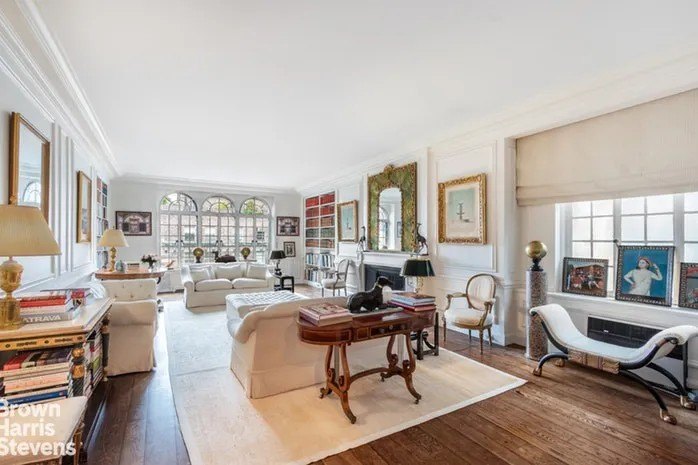Birds of a Feather: The Real-Life Homes of Truman Capote’s Swans

Getty Images (3); Realtor.com (3)
“Capote vs. the Swans,” FX’s high-society, back-biting melodrama, received an impressive 10 Emmy nominations across multiple categories.
It was the latest installment of creator Ryan Murphy‘s anthology series “Feud.” The eight-episode series features a parade of high-flying stars, including Naomi Watts, Diane Lane, and Tom Hollander, who all received award nominations, as well as Demi Moore, Molly Ringwald, Calista Flockhart, and Chloë Sevigny.
The group portrays socialites who befriended author Truman Capote, and whom he dubbed his “swans.”
After gaining their trust, he betrayed the women in a thinly veiled fictionalized tell-all, titled “La Côte Basque, 1965.” Not surprisingly, the women responded by icing him out of their exclusive social circle. Drama ensues!

FX
The series is based on the book “Capote’s Women: A True Story of Love, Betrayal, and a Swan Song for an Era,” by Laurence Leamer.
The adaptation is set in a bygone era of martini-fueled lunches at Manhattan’s La Côte Basque, the Plaza Hotel, and other incredible locales from the 1960s and ’70s. While the show itself was filmed mostly on sound stages, these real-life figures lived in real-life homes worthy of their social stature.
So where did Capote’s swans nest? Let’s take a look.
Truman Capote

Evening Standard/Hulton Archive/Getty Images
860 United Nations Plaza, 23rd Floor, New York, NY
With his earnings from the acclaimed true-crime novel “In Cold Blood” in 1965, the writer bought himself a swanky spot in Manhattan.
The 23rd-floor residence in the United Nations Plaza afforded him views of the East River and the United Nations. It was said to be filled with “animal-themed decor and his favorite flowers.”
It was located at 49th Street and First Avenue, close to his swans’ favored watering holes such as La Côte Basque, a now-defunct restaurant that was located at 5 East 55th Street, and the Plaza Hotel.

Realtor.com
From 1955 to 1965, Capote resided at 70 Willow St. in Brooklyn Heights. It was here that he first read about the murders in Kansas that he would later write about to much praise from the literary community. While writing some of his most notable works, he lived in a basement apartment of a Greek Revival townhouse owned by Broadway set designer Oliver Smith.
In an essay, he described how he talked his way into living there, as described in Untapped New York: “We sat on the porch consulting Martinis—I urged him to have one more, another. It got to be quite late, he began to see my point; yes, twenty-eight rooms were rather a lot; and yes it seemed only fair that I should have some of them.”
The 5,700-square-foot, three-floor building with a brick facade was built in 1899. It was last sold in 2012 for $12.5 million.
Barbara ‘Babe’ Paley

ullstein bild/ullstein bild via Getty Images)
820 Fifth Avenue, 9th Floor, New York, NY
The icon Barbara “Babe” Paley (Watts), a sort of superswan, was known to have feathered many nests, from Jamaica to New Hampshire to Long Island.
The socialite, who had been an editor at Vogue, frequently made the best dressed lists.
Capote himself said of her, “Mrs. P. had only one fault: she was perfect. Otherwise, she was perfect.”
So where does perfection reside? On Fifth Avenue, of course.
She and her husband, CBS executive William Paley, acquired a 20-room apartment in 1965 at 820 Fifth Avenue. A current listing for one of the units in the building calls it “one of Fifth Avenue’s most sought after white glove, limestone-clad cooperatives.”
Imagine a residence offering Central Park views and grand entertaining spaces, including a formal dining room, a library, and a large gallery, all with high ceilings and parquet floors.
The exclusive address was built and designed in 1916 by Starrett and Van Vleck in the neo-Italian Renaissance palazzo style.

Realtor.com
Slim Keith

Horst P. Horst/Conde Nast via Getty Images
The Verona
32 East 64th Street, New York, NY
The original “California Girl,” Slim Keith (Lane) was courted by the likes of Clark Gable and Ernest Hemingway.
She and her third husband, Kenneth, resided on the Upper East Side in a “lovely landmarked building” where her neighbors included TV newsman Mike Wallace and stage and screen actress Kitty Carlisle Hart.

Realtor.com
C.Z. Guest

Cecil Beaton/Condé Nast via Getty Images
1 Sutton Pl S #PH, New York, NY
The elegant C.Z. Guest (Sevigny) was once painted by Diego Rivera and became a fixture on the social scene, along with her husband, steel heir Winston Frederick Churchill Guest. The couple stayed friends with Capote even after his salacious story in Esquire came out.
When Guest died in 2003, she left behind a real estate legacy. Her former Sutton Place penthouse is currently on the market for $26 million. It offers “divine East River and skyline vistas in all directions.” The 6,600-square-foot, top-floor apartment is now filled with glossy white surfaces and dramatic displays of pop art.
The couple also owned a “fabled family home” in Westbury, NY, according to the New York Post. The home had been in the family for decades before it was sold in 2014 for $5.6 million.
Guest’s daughter, Cornelia, sold the Long Island property, calling the transaction “a bittersweet moment.” The home has since been razed.

Realtor.com
Lee Radziwill

Bettmann/Getty Images
160 East 72nd Street, New York, NY
Although she was the younger sister of Jacqueline Kennedy Onassis, Lee Radziwill (Flockhart) captured attention in her own right.
Radziwell was a fashion plate and a fixture of the social circuit. Shortly after she died in 2019, the former PR executive, who was also a princess by marriage, her three-bedroom apartment on the Upper East Side was sold for $4,250,000. The elegant pre-war unit took up the entire 15th floor of the stone building from the 1920s, according to Mansion Global.
The delightful dwelling included hardwood floors, built-in bookshelves, and a private elevator vestibule. Built in 1928, the building is incorporated into the Upper East Side historic district.

Realtor.com
Ann Woodward

Photo by Horst P. Horst/Conde Nast via Getty Images
Sunken Orchard, Oyster Bay, New York
Perhaps the most dramatic and tragic figure, social figure Ann Woodward (Moore) shot and killed her husband in their Oyster Bay home in 1955, mistaking him for an intruder.
Life magazine called it “the shooting of the century,” and though she was not charged with a crime, she became a social outcast. The Oyster Bay home was partly knocked down after it was sold in 1957.
Capote dubbed her “Mrs. Bang Bang” and described her in “La Côte Basque, 1965” as a “cold-blooded killer.” Before his story was published, she took her own life.
Woodward also had a Manhattan apartment in the Carnegie Hill section of Fifth Avenue. The building overlooks Central Park and was built in 1927.
Categories
Recent Posts










GET MORE INFORMATION

